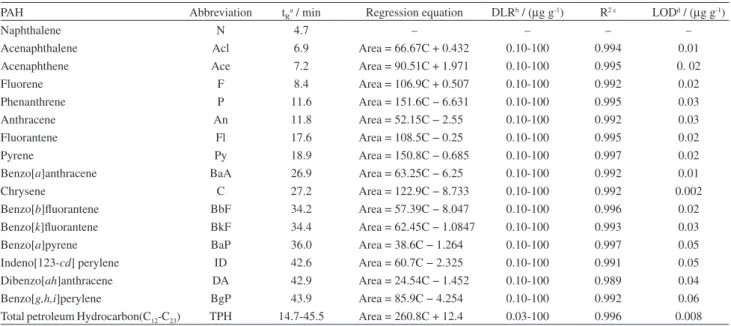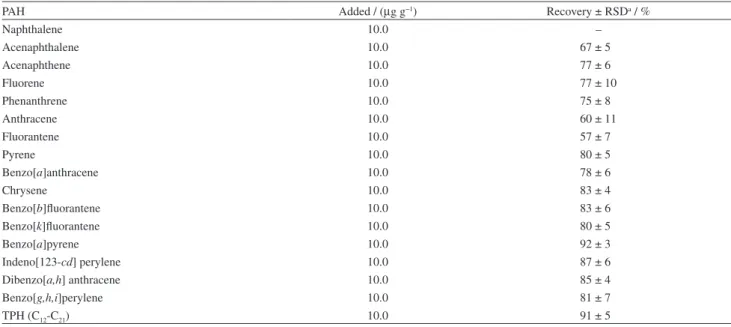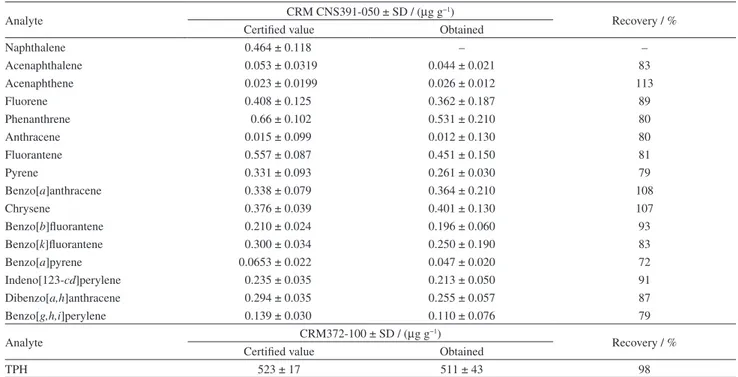Article
J. Braz. Chem. Soc., Vol. 24, No. 4, 639-644, 2013. Printed in Brazil - ©2013 Sociedade Brasileira de Química 0103 - 5053 $6.00+0.00
A
*e-mail: jalalhassan@ut.ac.ir, jalalhassan1355@yahoo.com
Application of Low Density Homogeneous Liquid-Liquid Extraction Combined with
GC for TPH and PAH Determination in Semi-micro Solid Samples
Jalal Hassan,*,a Mohadeseh Izadib and Soma Homayonnejadb
aDepartment of Toxicology, Faculty of Veterinary Medicine, University of Tehran, Qareeb Street, Azadi Av.,CP 14155-6453 Tehran, Iran
bAnalytical Chemistry Department, Azmoon Sanate Sabz Company, Tehran, Iran
No presente trabalho, uma técnica de pré-tratamento de amostra simples, rápida e econômica, extração líquido-líquido homogênea miniaturizada de baixa densidade (LDMHLLE), foi desenvolvida para a determinação de hidrocarbonetos policíclicos aromáticos (PAH) e hidrocarbonetos totais de petróleo (TPH) em amostras de sedimentos. O método LDMHLLE é baseado na extração líquido-líquido homogêneo com metanol, contendo n-hexano como solvente de densidade inferior à da água que imediatamente após adição de água forma uma fase distinta imiscível em água na parte superior do frasco. Esta fase pode ser facilmente separada e injetada no cromatógrafo gasoso com detector de ionização de chama (GC-FID) para quantificação. A linearidade foi obtida no intervalo de concentração de 0,100-100,00 e 0,030-100,00 µg g−1 para
PAH e TPH, respectivamente. Os coeficientes de correlação foram melhores do que 0,99 para PAH e TPH. O limite de detecção (LOD), com base na razão sinal-ruído (S/N), foi de 0,010-0,060 µg g−1
para os PAH e 0,008 µg g−1 para TPH. As recuperações relativas de PAH e TPH para amostras
de sedimento de nível fortificado de 10,0 µg g−1 foram 57-92 e 91%, respectivamente. O método
foi aplicado com sucesso em material de referência certificado, CRM372-100 para TPH e CRM CNS391-050 para PAH.
In the present work, a simple, rapid and economic sample pre-treatment technique, low density miniaturized homogeneous liquid-liquid extraction (LDMHLLE), was developed for determination of polycyclic aromatic hydrocarbons (PAH) and total petroleum hydrocarbons (TPH) in sediment samples. The LDMHLLE method is based on the homogeneous liquid-liquid extraction with methanol containing n-hexane as a solvent of lower density than water that after addition of water forms a distinct water immiscible phase at the top of the vial. This phase can be easily separated and injected to the gas chromatography with flame ionization detector (GC-FID) instrument for quantification. The linearity was obtained in the concentration range of 0.100-100.00 and 0.030-100.00 µg g−1 for PAH and TPH, respectively. Correlation coefficients were better than
0.99 to for PAH and TPH. The limit of detection (LOD), based on the signal-to-noise ratio (S/N), was 0.010-0.060 µg g−1 for PAH and 0.008 µg g−1 for TPH. The relative recoveries of PAH and
TPH for sediment samples at spiking level of 10.0 µg g−1 were 57-92 and 91%, respectively. The
method was successfully applied to corresponding standard reference material, CRM372-100 for TPH and CRM CNS391-050 for PAH.
Keywords: PAH, TPH, gas chromatography-flame ionization detector, LDMHLLE, preconcentration
Introduction
In recent times, the contamination of the environment by petroleum hydrocarbons is potentially widespread because modern society uses so many petroleum-based products (for example, gasoline, kerosene, fuel oil,
mineral oil and asphalt). Hydrocarbons are quantitatively the most important constituents of petroleum, and arise from natural as well as anthropogenic sources.1 Total
diesel fuel can affect human health. Therefore, TPH are monitored globally.2 Polycyclic aromatic hydrocarbons
(PAH) are one of major classes of organic pollutants that are released into the environment and mostly due to human activities. PAH in the environment are formed mainly during the incomplete combustion of organic matter at high temperature by both domestic and industrial activities. Exhaust emission from vehicles is also one of the major sources of PAH in urbanized areas. Major routes of entry of PAH into aquatic environment are spillage and seepage of fossil fuels, discharge of domestic and industrial wastes, fallout or rainout from air and runoff from land. The United States Environmental Protection Agency (USA EPA) has recommended some of them as priority pollutants.3 Evaluation and monitoring of trace
levels of these compounds from different environmental matrices are imperative.4,5 Numerous polycyclic
aromatic hydrocarbons (PAH) are carcinogenic, making their presence in foods and in the environment a health concern. Regulations around the world limit levels of a variety of PAH in drinking water, food additives, cosmetics, workplaces and factory emissions. PAH have traditionally been separated using high performance liquid chromatography with UV detection (HPLC-UV), but the limits of detection of the method of the HPLC-UV techniques, employing direct injection of samples, are too high for the detection of the low concentrations in real samples that are near the regulated limit. HPLC-fluorescence, gas chromatography-mass spectrometry (GC-MS) and gas chromatography with flame ionization detector (GC-FID) can be use for PAH determination, but MS provides greater specificity than fluorescence (FL) or UV or FID detectors. Therefore, the analytes in these samples require preconcentration before the analysis.6 Some petroleum derived hydrocarbons
which are toxic to marine plants and animals may persist for long periods of time once released in the environment. The investigation on the hydrocarbon sources and fate is thus very useful in the evaluation of the environmental contamination in order to develop strategies for control and protection of coastal ecosystems. Ultrasonic, soxhlet extraction and supercritical fluid extraction are pretreatment methods for soil sample pretreatments. However, these extraction methods are time-consuming, tedious and expensive, and some of them require large volume of toxic solvents, which are harmful to the environment.
Some low-density extraction solvent methods was developed for extraction of pollutants from water samples7-9
and recently, our group introduced a new method for extraction of PAH and pesticide from sediment samples based on homogeneous liquid-liquid extraction (a method
based on the methanol extraction for sediment samples, that has proved to be very successful).10,11 In all homogeneous
liquid-liquid extraction (HLLE) methods, solvents of higher density than water (i.e., chlorinated solvents) have been used, and there is no report to use low density miniaturized homogeneous liquid-liquid extraction (LDMHLLE) for determination of TPH and PAH from sediment samples. The aim of this study was to develop and validate a cheap and reliable analytical procedure for routine analysis of PAH and TPH in sediment using LDMHLLE system and the determination of TPH and PAH was performed by GC-FID.
Experimental
Reagents and materials
All chemicals were of reagent grade and were used without further purification. Analytical grade methanol and n-hexane were purchased from Merck (Darmstadt, Germany). The working solutions were prepared at appropriate concentration from stock solutions. A standard mixture of the 16 EPA PAH (the number in parenthesis is equivalent carbon number): naphthalene (C11.7),
acenaphthene (C15.5), anthracene (C19.43), acenaphthylene
(C15.06), fluorene (C16.55), phenanthrene (C19.36), anthracene
(C19.43), pyrene (C20.8), benzo[a]anthracene (C26.37), chrysene
(C27.41), benzo[b]fluoranthene (C30.14), benzo[k]fluoranthene
(C30.14), benzo[a]pyrene (C31.34), dibenzo[a,h]anthracene
(C30.36), benzo[g,h,i]perylene (C34.01) and indeno[1,2,3-cd]
pyrene (C35.01) at a concentration of 2000 mg L−1 in
dichoroetane:benzene and a standard mixture of 35 normal alkanes (EC number) includes n-octane (C8), n-nonane
(C9), n-decane (C10), n-undecane (C11), n-dodecane (C12),
n-tridecane (C13), n-pentadecane (C15), n-hexadecane (C16),
n-heptadecane (C17), pristine(C19H40), n-octadecane (C18),
phytane (C20H42), n-nonadecane (C19), n-eicosane (C20),
n-heneicosane (C21), n-docoscane (C22), n-tricosane (C23),
n-tetracosane (C24), n-pentacosane (C25), n-hexacosane (C26),
n-heptacosane (C27), n-octacosane (C28), n-nonacosane (C29),
n-tricontane (C30), n-hentriacontane (C31), n-dotriacontane
(C32), n-tritriacontane (C33), n-pentatriacontane (C35),
n-hexatriacontane (C36), n-heptatriacontane (C37),
n-octatriacontane (C38), n-natriacontane (C39) and
n-tetratriacontane (C40) at a concentration of 500.0 mg L−1
material for PAH (CRM CNS391-050) purchased from RTC (Laramie, USA).
Apparatus
Chromatographic analysis was done by a 7890A Agilent gas chromatograph with flame ionization detector and equipped with an autosampler 7693 (Agilent Technologies, Avondale, PA, USA) and operated by Chemstation Software (Agilent Tecnologies). The carrier gas was nitrogen (99.999%) that was kept at a constant flow of 1.5 mL min−1. Hydrogen
gas was generated by a hydrogen generator (Dominick hunter, England) for FID at a flow rate of 30 mL min−1 and
the flow rate of zero air (99.999%, Air Products, UK) for FID was 400 mL min−1. A 30 m × 0.25 mm × 0.25 µm HP-5
capillary column was used for analyte separations. For PAH analysis, 1.0 µL of the sample was injected in the splitless mode at 280 °C. The temperature program used for the chromatographic separation of PAH was as follows: 80 °C for 1 min, temperature was increased at 25 °C min−1 to 160 °C,
and then temperature at 3 °C min−1 to 300 °C and held for
4 min, and the FID temperature was maintained at 325 °C. For TPH analysis, 2 µL of the sample were injected in the splitless mode at 290 °C. The temperature program used for the TPH chromatographic separations was as follows: 60 °C for 2 min, temperature was increased at 6 °C min−1
to 290 °C and hold for 7 min, and the FID temperature was maintained at 325 °C
Low density miniaturized homogeneous liquid-liquid extraction procedure
A sediment sample of 0.1000 g of homogenized and air-dried at room temperature (Karon River, Iran) was weighed into a 50 mL centrifuge tube, and then 10.0 mL methanol were added. The tube was mixed with a stirrer for 20 min and centrifuged at 3500 rpm for 5 min. Then, an aliquot of 6.0 mL methanolic phase was placed in a 10.0 mL volumetric flask, and 1.0 mL n-hexane as extraction solvent was added and vigorously shaken for 60 s. By adding water (4.0 mL) into solution, n-hexane was separated at the top of volumetric flask. An aliquot of 500 µL of the upper phase was solvent, and was drawn out by a Hamilton syringe and evaporated to near dryness under a nitrogen stream and re-dissolved in 50.0 µL n-hexane in a conical vial and 1.0 µL was injected in GC-FID.
Results and Discussion
GC-FID was calibrated by injecting extracts of 0.100 g of cleaned soil (without PAH and TPH) that were
spiked with the normal alkane mixtures (C12-C23) of 0.10, 0.30, 0.50, 1.00 and 2.00 µg g−1 and PAH mixtures
of 0.50, 1.00, 2.00, 4.00, 5.00 µg g−1, respectively.
Individual concentrations of n-alkanes were obtained by summing areas. All calibration curves were linear with correlation coefficients better than 0.998 and the limits of detection (signal-to-noise ratio of 3) obtained ranged from 0.01 to 0.06 µg g−1 and 0.008 µg g−1 for PAH and
TPH, respectively (Table 1). It is to be note that because of the naphthalene volatility, the peak of naphthalene was not found and the calibration curve was not obtained. Spiked soils containing PAH, the 0.50 µg g−1 of PAH
and 1.00 µg g−1 of TPH were chosen as the calibration
check standards, and were analyzed at intervals of one in every three injections. Response between two adjacent calibration check standards was monitored to check if the injector volumes were consistent. If the response between two adjacent check standards differed more than 10% then the samples between the adjacent check standards were reanalyzed assuming errors in the injections. These steps were taken to improve the quality of the data and to compensate for omitting internal standard (IS). IS was not considered for this part of the research due to: (i) GC-FID does not have the capability of identifying co-eluting compounds; (ii) IS can overlap with TPH; (iii) TPH components can be present in all regions of the chromatogram; (iv) compounds outside the C10-C33 range (i.e., C40) can be too insoluble as IS; (v) early eluting
compounds are too volatile as IS; and (vi) the front of the chromatogram just prior C10 may contain a mass of peaks
making it impossible to identify IS.
The extraction method was validated by the use of spiked sediment. The cleaned sediment (Tehran, Iran) samples were spiked at concentration levels of 10.0 µg g−1
for PAH and TPH to investigate their respective recoveries by the proposed method. Figure 1 and Figure 2 show the chromatogram of the spiked sediment sample obtained by this method and the results are summarized in Table 2. The applicability of the extraction method was examined by the extraction and determination of the TPH and PAH analysis in the standard reference materials, CRM372-100 and CRM CNS391-050. The values obtained from three replicates are given in Figure 1b and Table 3. The results showed satisfactory agreement with the certificated values.
Conclusions
Table 1. Regression equations, dynamic linear ranges, correlation coefficients and limit of detections for LDMHLLE in sediment
PAH Abbreviation tRa / min Regression equation DLRb / (µg g-1) R2 c LODd / (µg g-1)
Naphthalene N 4.7 – – – –
Acenaphthalene Acl 6.9 Area = 66.67C + 0.432 0.10-100 0.994 0.01
Acenaphthene Ace 7.2 Area = 90.51C + 1.971 0.10-100 0.995 0. 02
Fluorene F 8.4 Area = 106.9C + 0.507 0.10-100 0.992 0.02
Phenanthrene P 11.6 Area = 151.6C − 6.631 0.10-100 0.995 0.03
Anthracene An 11.8 Area = 52.15C − 2.55 0.10-100 0.992 0.03
Fluorantene Fl 17.6 Area = 108.5C − 0.25 0.10-100 0.995 0.02
Pyrene Py 18.9 Area = 150.8C − 0.685 0.10-100 0.997 0.02
Benzo[a]anthracene BaA 26.9 Area = 63.25C − 6.25 0.10-100 0.992 0.01
Chrysene C 27.2 Area = 122.9C − 8.733 0.10-100 0.992 0.002
Benzo[b]fluorantene BbF 34.2 Area = 57.39C − 8.047 0.10-100 0.996 0.02 Benzo[k]fluorantene BkF 34.4 Area = 62.45C − 1.0847 0.10-100 0.993 0.03
Benzo[a]pyrene BaP 36.0 Area = 38.6C − 1.264 0.10-100 0.997 0.05
Indeno[123-cd] perylene ID 42.6 Area = 60.7C − 2.325 0.10-100 0.991 0.05 Dibenzo[ah]anthracene DA 42.9 Area = 24.54C − 1.452 0.10-100 0.989 0.04 Benzo[g,h,i]perylene BgP 43.9 Area = 85.9C − 4.254 0.10-100 0.992 0.06 Total petroleum Hydrocarbon(C12-C23) TPH 14.7-45.5 Area = 260.8C + 12.4 0.03-100 0.996 0.008
at
R: retention time; bDLR: dynamic linear range; cR2: correlation coefficient; dLOD: limit of detection.
Figure 1. Chromatograms of PAH (10.0 µg g−1) extracted from spiked sediment sample (upper) and blank (lower) (a), and standard reference material
Figure 2. Chromatograms of TPH (10.0 µg g−1) extracted from spiked sediment sample (a), and standard reference material CRM372-100 (upper) and
blank (lower) (b) obtained with the proposed method.
Table 2. Recoveries of PAH and TPH from fortified sediment samples
PAH Added / (µg g−1) Recovery ± RSDa / %
Naphthalene 10.0 –
Acenaphthalene 10.0 67 ± 5
Acenaphthene 10.0 77 ± 6
Fluorene 10.0 77 ± 10
Phenanthrene 10.0 75 ± 8
Anthracene 10.0 60 ± 11
Fluorantene 10.0 57 ± 7
Pyrene 10.0 80 ± 5
Benzo[a]anthracene 10.0 78 ± 6
Chrysene 10.0 83 ± 4
Benzo[b]fluorantene 10.0 83 ± 6
Benzo[k]fluorantene 10.0 80 ± 5
Benzo[a]pyrene 10.0 92 ± 3
Indeno[123-cd] perylene 10.0 87 ± 6
Dibenzo[a,h] anthracene 10.0 85 ± 4
Benzo[g,h,i]perylene 10.0 81 ± 7
TPH (C12-C21) 10.0 91 ± 5
Table 3. Concentrations certified by the CRM372-100 for TPH and CRM CNS391-050 for PAH and determined by the proposed method
Analyte CRM CNS391-050 ± SD / (µg g
−1)
Recovery / % Certified value Obtained
Naphthalene 0.464 ± 0.118 – –
Acenaphthalene 0.053 ± 0.0319 0.044 ± 0.021 83
Acenaphthene 0.023 ± 0.0199 0.026 ± 0.012 113
Fluorene 0.408 ± 0.125 0.362 ± 0.187 89
Phenanthrene 0.66 ± 0.102 0.531 ± 0.210 80
Anthracene 0.015 ± 0.099 0.012 ± 0.130 80
Fluorantene 0.557 ± 0.087 0.451 ± 0.150 81
Pyrene 0.331 ± 0.093 0.261 ± 0.030 79
Benzo[a]anthracene 0.338 ± 0.079 0.364 ± 0.210 108
Chrysene 0.376 ± 0.039 0.401 ± 0.130 107
Benzo[b]fluorantene 0.210 ± 0.024 0.196 ± 0.060 93
Benzo[k]fluorantene 0.300 ± 0.034 0.250 ± 0.190 83
Benzo[a]pyrene 0.0653 ± 0.022 0.047 ± 0.020 72
Indeno[123-cd]perylene 0.235 ± 0.035 0.213 ± 0.050 91
Dibenzo[a,h]anthracene 0.294 ± 0.035 0.255 ± 0.057 87
Benzo[g,h,i]perylene 0.139 ± 0.030 0.110 ± 0.076 79
Analyte CRM372-100 ± SD / (µg g
−1)
Recovery / % Certified value Obtained
TPH 523 ± 17 511 ± 43 98
and expensive apparatus that are commonly used in other extraction methods. The proposed method is simple, rapid, cheap and environmentally friendly.
References
1. Benson, N. U.; Essien, J. P.; Curr. Sci.2009, 96, 25. 2. USEPA, 2010, 49, 209, Washington, DC, USA, www.buchi.
com.
3. Hou, L,; Lee, H. K.; J. Chromatogr., A2002, 976, 377. 4. Luis, H.; Figueiredo, M.; Wagener, A.; L. R.; Dagaut, J.;
Saliot, A.; J. Braz. Chem. Soc.2008, 19, 516.
5. Application Note 213, Determination of Polycyclic Aromatic Hydrocarbons (PAH) in Tap Water Using On-Line Solid-Phase
Extraction Followed by HPLC with UV and Fluorescence
Detections. www.dionex.com accessed in January, 2013.
6. Chen, H.; Chen, R.; Li, S.; J. Chromatogr., A2010, 1217, 1244. 7. Zacharis, C. K.; Tzanavaras, P. D.; Roubos, K.; Dhima, K.;
J. Chromatogr., A2010, 1217, 5896.
8. Cheng, J; Matsadiq, G.; Liu, L.; Zhou, Y. W.; Li, J. K.; J. Chromatogr., A2011, 02, 049.
9. Shamsipur, M.; Hassan, J.; J. Chromatogr., A2010, 1217, 4877. 10. Hassan, J.; Farahani, A.; Shamsipur, M.; Damerchili, F.;
J. Hazard. Mater.2010, 184, 869.
Submitted: November 4, 2012


